Best Place to Birdwatch
A.D. "Doug" Barnes Park

What the hell is pine rocklandç It's what used to cover much of the Miami Rock Ridge and other sections of South Florida. Much of this ecosystem is now gone, but there are still outcroppings here and there where you can get a taste of what this region used to look like. A.D. Barnes Park is one of these natural museums, and a magnet for bird life that has not yet moved out to the country. The National Audubon Society has named it one of the top ten birding locations in Florida and it is part of the Great Florida Birding Trail. Over the years almost 200 species of birds have been spotted here, including the swallow-tailed kite, ruby-throated hummingbird, cedar waxwing, red-shouldered hawk, greenback heron, red-wing blackbird, and a few lost parakeets as well.
- 3401 SW 72nd Ave., Miami, 33155 Map
- 305-666-5883
- miamidade.gov/parks/ad-barnes.asp
Best Local Girl Gone To Heaven
M. Athalie Range
Mary Athalie Range started out as a typical Miami transplant, but her decades of civic activism and public service became one of the city's great stories. In the late Forties, conditions at her children's Liberty City school jump-started the activist in Range. Her successful work in the PTA opened doors that eventually led to her becoming the first African-American woman to sit on the Miami City Commission. There she fought hard to correct the injustices that had long made life difficult for African Americans and other minority groups. By 1971 she had proven her effectiveness so thoroughly that then-Gov. Rubin Askew appointed her the secretary of the Department of Community Affairs for the State of Florida. When she passed away this past November at age 91, she was still active as the chair of the Virginia Key Beach Park Trust, and busy with restoration of the historic black sections of Virginia Key. She earned many citations for her public work, but she was also successful in the private sector as director of Range Funeral Homes, which still operate today. Thank you, Commissioner Range.
Best Snorkeling Spot
Indian Key Historic State Park

We all know Pennekamp State Park is for the tourists and Biscayne National Park is for the serious snorkelers, but sometimes you just want to swim off the beaten path. A few miles west of Pennekamp is a popular snorkeling and recreation spot called Indian Key Historic State Park. It lies unconnected to the Overseas Highway, which means you can only reach it by boat, kayak, or heavy-duty swim fins, but rentals and tours are available from nearby marinas. (Robbie's Marina is a popular one, where you can also hand-feed large tarpon.) Instead of a sandy beach, the island has a coral/rocky shoreline with plentiful sea life just inches away from shore. Dolphins, manatees, sharks, rays, crabs, and lobster are seen frequently in the flats, while large fish are visible in the channels. The island itself is a historic site. It was the former Dade County seat (until Monroe County was established in 1836), and is home to a sunken galleon salvage fleet and Dr. Henry Perrine's botanical garden. Native Americans used it for thousands of years before that. Though most of the buildings are gone, lots of artifacts — including Perrine's plants — remain. Don't forget your diver down flag.
- Mile marker 78.5, Islamorada, 33036 Map
- 305-664-2540
- www.floridastateparks.org/indiankey
Best Fifteen Minutes of Fame
José Varela
It's the day after Thanksgiving! What should we doç We could eat turkey sandwiches and draw cartoons. Or go to Wal-Mart at 5:30 a.m. and jostle Christmas shoppers.... Hey, I know! Let's put on our FBI polo shirt and fatigues. We can pretend our fake machine gun is real. Then we can barricade ourselves inside the newsroom of El Nuevo Herald and proclaim ourselves editor! The mayor, the police chief, the FBI, CNN, the local news media, and various SWAT teams are probably bored as hell. They'll love it! Whyç What do you mean, "why"ç
Best Overnight Snorkeling Spot
Jules' Undersea Lodge
The future is now! Well, almost. Somewhere along the way, the Jetsonesque future that baby boomers envisioned disappeared. Instead of personal space ships, we got the Segway. Instead of Rosie the Maid, we got the Swiffer Sweeper. Instead of incredibly tall, funky-looking skyscrapers ... oh, we did get those, and we also got living quarters under the sea. Though it's not the quite the Taj Mahal of futuristic sea labs, Jules' Undersea Lodge is probably the only chance you'll get to sleep with the fishes — the easy way. Basically this is a completely submerged hotel — even the entrance is underwater. It also doubles as an artificial reef, so there is guaranteed sea life to observe through the large windows. As well as the usual hotel amenities, they have a chef, and offer scuba instruction so that novice guests can enjoy the facility to its fullest. Maybe you'll even meet a mermaid and robotic dolphin and invite them over to watch TV.
- Mile Marker 103.2, Key Largo, 33037 Map
- 305-451-2353
- www.jul.com
Best Religious Figure
Father Albert Cutié

He was born Alberto R. Cutié in San Juan, Puerto Rico, to Cuban parents. An imposing presence at six feet tall, the 36-year-old sports a thick head of closely cropped black hair and blemish-free, tanned skin. When he smiles, his piercing blue eyes sparkle affectionately and his lips part to reveal a gleaming row of pearly whites. But it's not his classic good looks that draw in the crowds. It's his no-nonsense, flexible take on the Almighty. See, the mild-mannered, witty, and humble Cutié is a celibate priest who leads the congregation at St. Francis de Sales Catholic Church in Miami Beach. And he's a favorite among congregations both here and overseas — he hosts a popular Spanish-language TV show that airs on Telemundo, and a spot on Radio Peace, which broadcasts nationwide as well as in every country in Latin America. He doesn't shove narrow-minded opinions down your throat; he doesn't point fingers, yelling "sinner"; and he doesn't think gays should burn in Hell. Simply put, at a time when organized religion is drowning in a man-made sea of scandal, Cutié is a breath of fresh air. Not to mention easy on the eyes.
- 600 Lenox Ave., Miami Beach, 33139 Map
- 305-638-4475
Sometimes the best stargazing happens only in the daytime. The closest star to Earth is, of course, the sun. Its blinding light hides a spectacular show that gracious members of the Southern Cross Astronomical Society (SCAS) reveal for free once a week with their specialized equipment. Flares, sunspots, and prominences regularly dance across their viewfinders, but that's not all a budding astronomer can see in the daytime. The recent comet McNaught was only visible to skywatchers in the northern hemisphere during daylight hours, and there is usually a planet or two that rewards a little attention from snooping telescopes.
Best Day Trip
Chokoloskee
It's not so much that time forgot Chokoloskee. It's more like Chokoloskee forgot time. A magical little community of stilt houses and trailers spanning out from a postage stamp-size downtown, Chokoloskee is just south of Everglades City on the far end of the Tamiami Trail. It sure feels like the far end of something, what with the literary ghosts (Peter Mathiessen's Bone by Bone is set here), and distinctly unhurried pace (golf carts are a common mode of transport). Little more than a sandy rise amid the Ten Thousand Islands wilderness, this is the west coast's most southerly community. No hurry here; just hang out in front of the "Chokoloskee Mall," basically a general store and post office; have some clam chowder at Big House Coffee and soak it all in. Shake off the stupor with a paddle — there's easy access to the Gulf Coast Visitor Center, and gorgeous nearby canoe/kayak routes such as the Turner River and the Wilderness Waterway.
Best Disappearing Act
Michael Patrick
People come and go, but Michael Patrick disappeared — and then reappeared, a day later, in handcuffs. The escape artist, who performed escapes at the Key West Sunset Celebration for fourteen years, announced last Halloween night that, in honor of the 80th anniversary of Harry Houdini's death, he'd be departing from the regular program of straitjackets and ropes. He then dove into the ocean and, as far as anyone present could tell, never came back up. Together, cops and the Coast Guard assembled a team of divers, boats, and helicopters to find Patrick's corpse. When they finally found him, alive and well, outside his apartment the next afternoon, they threw him in the county jail and fined him $60,000. Patrick, embittered by the experience, says his next escape will be to get the hell out of Florida.
Best Bus Ride
Julia Garcia Transit Bus to the Keys
Fate has chewed you up, spit you out, and left you battered and bruised in the parking lot of the Florida City Wal-Mart Supercenter. You've lost your job, your girl, your car, and your reason to live. You have $3.85 to your name. And then, like an angel out of a Jimmy Buffett song, you see the faint bright silhouette of the Julia Garcia Transit (JGT) bus roll into view. This is your chance to hightail it to the Keys and make a brand-new start, full of cheap beer and shellfish. Sure it'll take four-and-a-half hours to get to Key West, because the bus makes every conceivable stop along the way, but it's all you've got left in the world. And, man, are they dependable. JGTs leave seven times daily, seven days a week, beginning at 5:15 a.m. and ending at 11:15 p.m. Ask the person next to you to wake you up to catch the Keys shuttle, which you can catch at the end of the JGT line in Marathon, in the parking lot of the Brass Monkey Liquor Store. Everything's gonna be all right.





